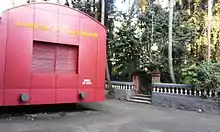Wagon tragedy
The wagon tragedy or Bellary train tragedy was the death of 64[1] prisoners on 10 November 1921 in the Malabar region of Kerala state of India. The prisoners had been taken into custody following the Mappila Rebellion against British in various parts of Malappuram district . Their deaths through apparent negligence discredited the British Raj and generated sympathy for the Indian independence movement.
| Wagon tragedy | |
|---|---|
 Wagon Tragedy Memorial at Tirur | |
| Details | |
| Date | 10 November 1921 |
| Location | While in transit from Tirur to Podanur Junction, British India |
| Country | British India |
| Line | Shoranur–Mangalore section, Jolarpettai–Shoranur line |
| Operator | Madras and Southern Mahratta Railway |
| Incident type | Asphyxiation |
| Cause | Overcrowding |
| Statistics | |
| Trains | Prisoner transport train |
| Deaths | 67 |
In order to attract more Muslim support to the Indian National Movement, Mahatma Gandhi and the national leaders of India initially supported the Khilafat movement and merged it to the famous Non Co-operation Movement. This succeeded in bringing almost all sections of Indians under one flag for a Pan-Indian movement for the first time. The southern Malabar district welcomed this movement in a great spirit. However, in Eranad and Walluvanad taluks it took the form of an armed rebellion by the Muslim Mappila community.
The Muslims slaughtered 10,000 Hindus. After violent clashes between police and protesters, martial law was introduced and the rebellion was mostly crushed.
On 10 November 1921, when the uprising was near its end, almost 100 detained Muslim rebels were sent by train from Tirur to the Central Prison, Bellary in the Madras Presidency. During the return journey, 64 of the 100 rebels suffocated to death in the closed railroad wagon.[2] Historian Sumit Sarkar referred to it as the "Black Hole of Podanur". A monument to this event can be seen at Tirur.[3]
Wagon tragedy victims and memorial
The people who were killed in the tragedy were mainly from southern India. Tirur, Kerala, where exists a monument for the remembrance of event.
References
- Panikkar, K. N., Against Lord and State: Religion and Peasant Uprisings in Malabar 1836-1921
- "64 out of 100 Moplah prisoners suffocated in a closed car on train in India" (PDF). The New York Times. The New York Times. 22 November 1921. Retrieved 6 January 2020.
- "It was a wagon massacre, not tragedy!" The Asian Age daily, 21 November 2011
- Dr. Sivadasan P., Wagon Tragedy: Kanalvazhiyile Koottakuruthi, National Book Stall, Kottayam, 2011 (ISBN 9788192282206)
External links
| Wikimedia Commons has media related to Malabar Rebellion. |
